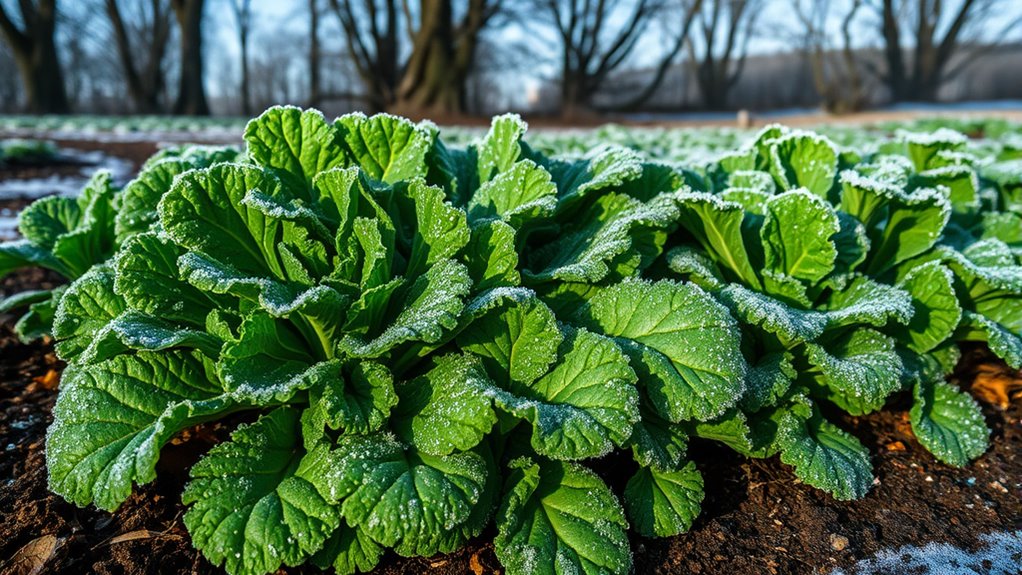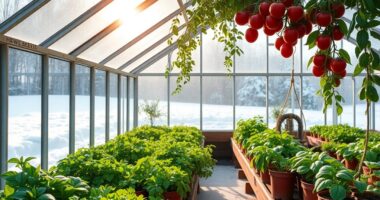Winter greens, like kale, collards, and spinach, thrive in cold weather, providing fresh produce when other plants fail. Plant them in well-drained soil with full sun exposure, and consider succession planting for continuous harvests. Use mulch to retain warmth and row covers for added protection. These nutrient-rich veggies not only boost your health but also fit well in salads or stir-fries. There are more tips and tricks to ensure your winter garden flourishes.
Key Takeaways
- Choose hardy winter greens like kale, spinach, and collards that can withstand cold temperatures and frost.
- Ensure well-drained soil and full sun exposure for optimal growth during winter months.
- Use row covers to provide additional warmth and protect plants from harsh weather.
- Regularly weed, fertilize, and monitor for pests to maintain healthy winter crops.
- Harvest leaves as needed to encourage new growth and enjoy fresh greens throughout winter.
Best Winter Greens for Cold Weather
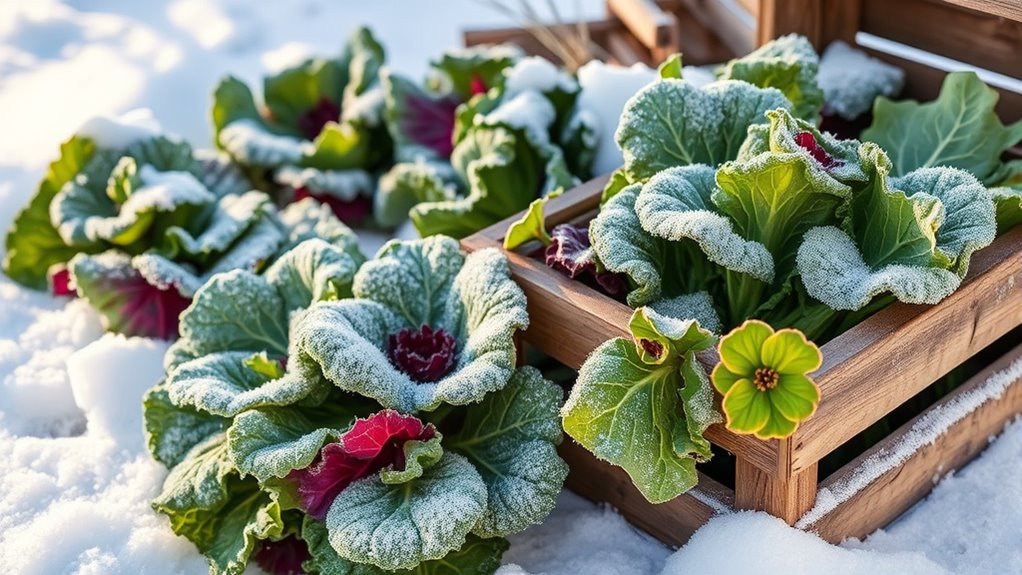
When it comes to growing leafy vegetables in cold weather, which greens can thrive despite the chill?
You'll find that kale and spinach are top choices, with varieties like *Red Russian* and *Giant Winter Spinach* surviving temperatures as low as 20°F (-7°C) and 15°F (-9.5°C), respectively. In addition to these, Winter Density lettuce consistently outperforms other varieties in cold conditions, making it a reliable option for winter gardens.
Collard greens can handle even colder conditions, tolerating down to 10°F (-12°C). Swiss chard and mustard greens also offer resilience against light frosts.
If you're looking for additional options, consider arugula and mâche, which can withstand light frosts, or Claytonia, which thrives in low light and cold. For a splash of color, *Rouge d'Hiver* lettuce not only survives winter but also intensifies in hue with the cold.
Planting Strategies for Winter Greens
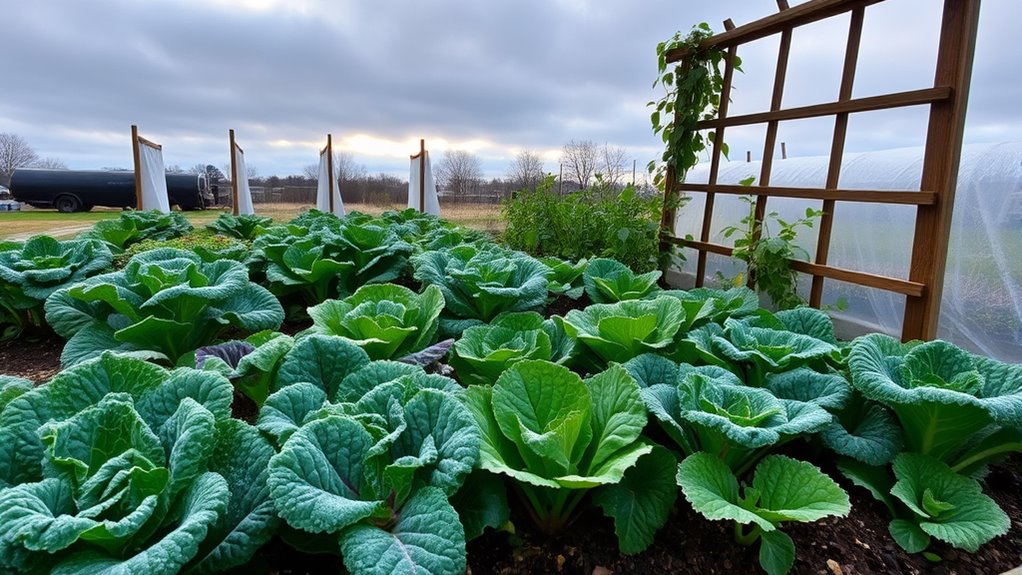
As you explore the best winter greens for your garden, understanding effective planting strategies can significantly enhance your success.
Start by planting seeds in late summer or early fall, ensuring soil temperatures are above 40°F for optimal germination. You can choose to start from seeds for a fuller growth experience or use seedlings for an early harvest. To ensure a successful winter harvest, consider building a backyard greenhouse to create a controlled environment for your plants. Additionally, keeping an eye on water sources is crucial, as winter conditions can lead to unexpected fluctuations. Incorporating well-drained soil into your planting strategy will also improve the health of your winter greens.
Plant seeds in late summer or early fall for the best winter greens, ensuring soil temperatures exceed 40°F for germination.
Enhance your soil's fertility by adding nitrogen sources like alfalfa or fish meal. Don't forget to mulch; it retains moisture and suppresses weeds. Additionally, consider using soil-sprouted shoots as a productive method to grow greens indoors with minimal space and time investment.
If you're limited on space, consider indoor growing techniques, such as sprouting seeds or using mini trays on a sunny windowsill. These strategies will help you maximize yields and enjoy fresh greens throughout the winter months.
Cold-Weather Protection Methods
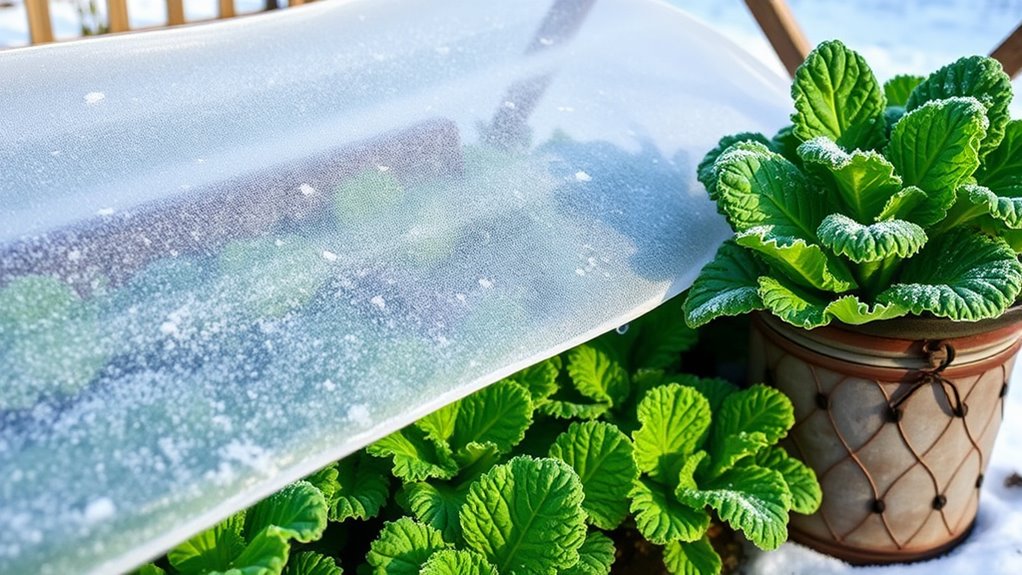
To protect your leafy vegetables from harsh winter conditions, it's crucial to implement effective cold-weather protection methods.
Start by applying mulch to regulate soil temperature and retain moisture, keeping roots safe from extreme cold. A thick layer of mulch can also provide insulation against low winter temperatures, further protecting your plants from young trees and shrubs that are particularly vulnerable. This method is similar to how raw food diets can improve digestion and overall health by maintaining the integrity of the ingredients. Additionally, understanding the importance of long-term financial planning for gardening investments can help you allocate resources effectively.
Use row covers for frost protection—each layer adds about 4°F to 6°F of warmth.
Consider cold frames or greenhouses to create a warmer microclimate, extending your growing season.
For added defense, wrap vulnerable plants with burlap to shield them from wind and desiccation.
Don't forget to monitor frost forecasts and adjust your protective measures accordingly.
These strategies will help ensure your winter greens thrive despite the challenges of cold weather.
Nutritional Benefits of Winter Greens
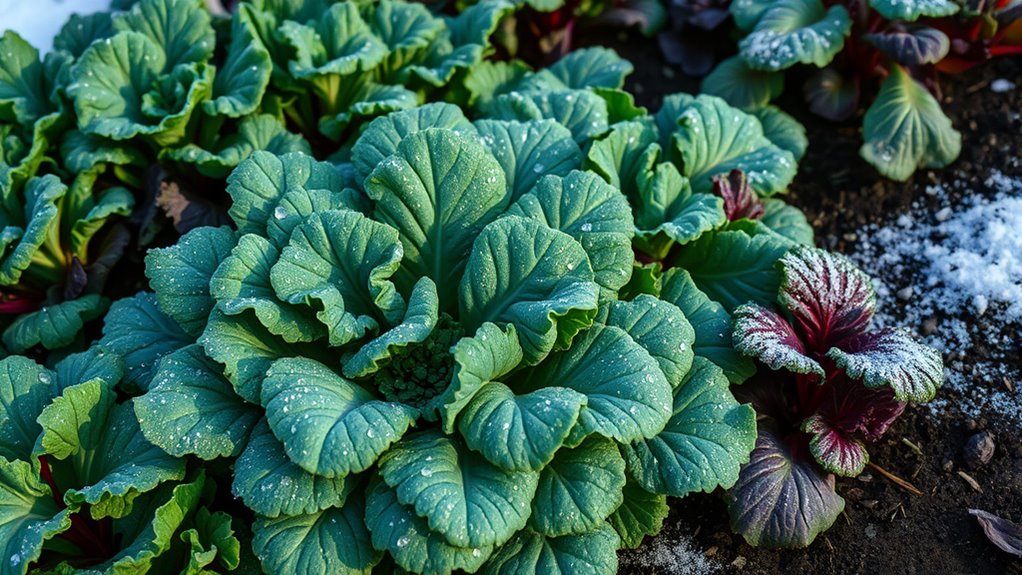
After safeguarding your leafy vegetables with effective cold-weather protection methods, it's time to appreciate the nutritional benefits these winter greens bring to your diet.
Packed with vitamins A, C, and K, they support vision, immune function, and skin health. Minerals like potassium, magnesium, and iron play crucial roles in your physiological functions. Plus, their high antioxidant content helps protect your cells from oxidative stress. Regular consumption of winter vegetables is linked to a reduced risk of chronic diseases. Additionally, winter greens are low in calories, making them a weight management-friendly option.
You'll also benefit from their fiber, which aids digestion and keeps you feeling full. Winter greens, such as kale, spinach, and collard greens, offer unique advantages too—like calcium for bone health and phytochemicals that may reduce inflammation.
Incorporating these greens into your meals can significantly boost your overall health.
Challenges in Growing Winter Greens
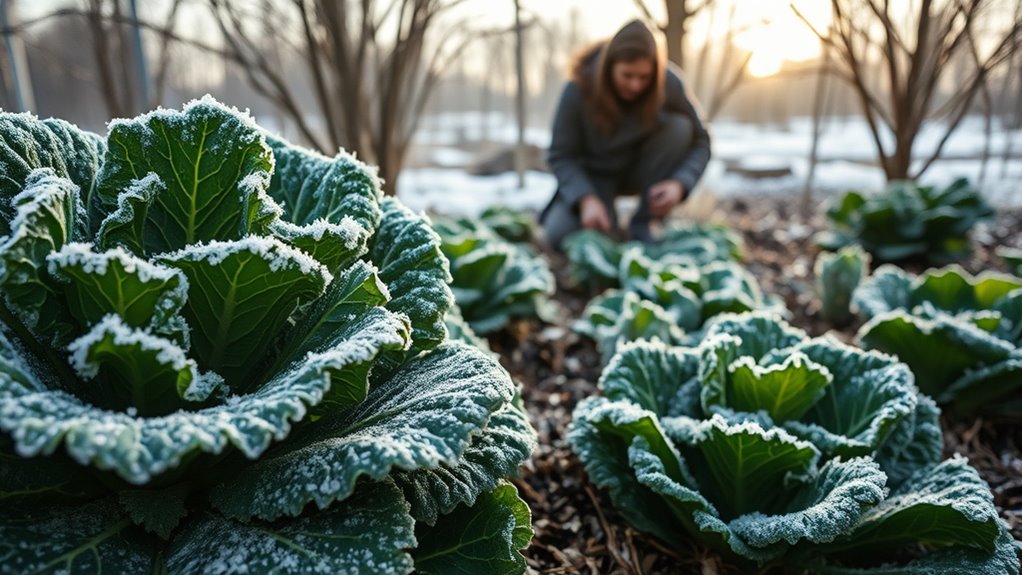
Growing winter greens presents several challenges that can test even the most dedicated gardener. First, you need to select cold-hardy varieties that can withstand frost and freezing temperatures. Keep in mind that some greens, like arugula, need specific soil temperatures to germinate. You'll also notice they grow more slowly than summer crops, demanding a longer growth period. Additionally, light levels require at least 10 hours of sunlight daily for optimal growth, and nighttime freezing can halt growth. Environmental factors add to the difficulty; your greens require at least 10 hours of sunlight daily, and nighttime freezing can halt growth. You must protect them from harsh winds and ensure proper soil drainage. Additionally, frost protection, pest management, and regular monitoring are crucial for maintaining healthy plants. Planning ahead is vital to ensure a steady supply of winter greens.
Tips for Successful Winter Gardening

While winter gardening may seem daunting, following a few essential tips can lead to a successful and bountiful harvest of leafy greens. Start by planting cold-hardy varieties like kale and spinach in late summer or early fall, ensuring they establish before winter hits. Select a sunny spot with at least six hours of sunlight daily and maintain well-draining soil to prevent root issues. Utilize protective structures, such as cold frames or mini hoop houses, to shield your plants from frost. Additionally, consider using self-watering planters to help maintain consistent moisture levels, which is crucial for root health. Larger plants generally require more water due to their increased leaf surface area, so keep an eye on your watering practices. Keep the soil moist to protect roots and harvest outer leaves regularly to promote growth. If you're gardening indoors, use south-facing windows or grow lights to ensure your greens thrive even in colder months. Additionally, consider using cold-weather methods to extend your growing season and enjoy fresh vegetables year-round. Happy gardening!
Frequently Asked Questions
What Tools Are Essential for Growing Winter Greens Effectively?
To grow greens effectively in winter, you'll need several essential tools.
A hori hori knife helps with soil preparation and plant maintenance. Long pruning gloves keep you warm and protected.
Row covers shield your plants from frost, while cold frames or mini greenhouses create controlled environments.
Don't forget an electric leaf blower for cleaning debris.
With these tools, you're set to cultivate healthy greens despite the chilly weather!
Can Winter Greens Be Grown Indoors During Cold Months?
Yes, you can grow winter greens indoors during cold months!
To do this successfully, ensure you provide enough light, either from natural sunlight or grow lights. Keep the temperature between 60°F and 70°F and maintain humidity to prevent drying.
Use high-quality potting soil and ensure good air circulation to avoid diseases.
How Often Should I Water Winter Greens in Winter?
Watering winter greens is like nurturing a delicate dance; you want to keep the rhythm just right.
Generally, you should water every 3 to 4 days, or when the top inch of soil feels dry to the touch. Deep watering less frequently helps roots reach for moisture, ensuring they thrive.
Remember to adjust based on rainfall and avoid watering before frost. Your greens will flourish with consistent moisture and care!
What Are the Best Companion Plants for Winter Greens?
When growing winter greens, you'll want to choose companion plants that enhance their growth and deter pests.
Consider pairing kale with chamomile and dill, while collard greens thrive near marjoram and carrots.
For arugula, lettuce and radishes make perfect companions.
Spinach does well alongside mustard greens and celery.
How Do I Know When to Harvest Winter Greens?
To know when to harvest winter greens, observe their size and maturity; they should be almost full size.
Check for frost tolerance; it's best to harvest when plants aren't frozen. Aim to harvest during the warmest part of the day, especially after cold spells.
Different varieties mature at different times, so keep an eye on your specific greens.
Conclusion
Embracing winter greens not only brightens your cold-weather garden but also enriches your plate with wholesome nutrition. As you sow those vibrant leaves, you might find a surprising synergy: the more you nurture them, the more they'll thrive against the chill. When you face challenges, remember that each setback can lead to unexpected growth. So, gear up for a rewarding winter gardening experience, and you'll discover that even in the frost, life finds a way to flourish.
